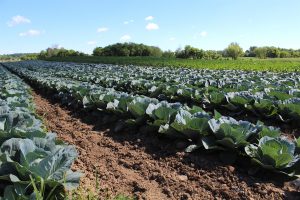WOOSTER, Ohio — Organic farmers have long believed in the benefits of a healthy soil and balancing nutrients like calcium, magnesium and potassium.
Now, farmers and scientists are working together to look at the scientific differences in organic soils, and help bridge the gap between farmer experience and scientific study.
Researchers and farmers spoke about their collaborative work June 20 during a tour of Raymond Yoder Jr.’s organic farm, known as Artisan Acres. This 17-acre produce farm, part of the Greenfield Farms cooperative, grows vegetables that are sold in grocery stores like Kroger, Meijer and Earth Fare.
Collaborative effort
Yoder opened his farm to Ohio State University researchers to test and document the perceived benefits of soil balancing and organic agriculture.
So far, he said working with the researchers has required patience by both parties, but he said “it’s progress” and something the organic industry needs.
“There’s so much that we don’t know and there’s so much that we can learn by seeing what we look at and observing,” he said. “I think the only way we’ll get anywhere is if we continue doing what we’re doing.”

Douglas Jackson-Smith, an OSU natural resources professor with a background in sociology, said the gap between organic farmers and researchers is still wide, but “we’re hopeful in the four years of this project, we’ll at least begin to close that communications gap and get us closer to a common conversation.”
Soil balancing
According to a fact sheet by OSU, soil balancing is a soil and soil fertility management strategy based on the Base Cation Saturation Ratio — or the optimum ratio of plant nutrients, calcium, magnesium and potassium.
Soils can be balanced in a variety of ways, but the common method is adding calcium-rich minerals, such as limestone and gypsum, in order to raise the calcium levels.
Balanced soils can be difficult or even impractical in some locations, and usually require some maintenance, according to OSU.
Organic supporters are hoping the scientists will be able to document the benefits of soil balancing.
“We already know the practice works, they (scientists) just need to, through empirical evidence, anoint it as sound science,” said Eric Pawlowski, sustainable ag educator with the Ohio Ecological Food and Farm Association, one of the project partners.
Results to come
The research at Yoder’s farm is still in the beginning stages, and is part of a larger research effort by OSU scientists, which includes additional private farms, and sites owned by OSU.
In addition to OEFFA, researchers are working with the U.S. Department of Agriculture’s National Institute of Food and Agriculture to provide more clarity about the benefits and challenges of soil balancing.
What is clear so far, at the Yoder farm, is that he has achieved a solid produce operation that grows healthy produce and in an efficient, profitable manner.
The tour drew nearly 80 people, who observed a mostly weed-free operation, with loamy soils and lush produce. Many comments were made about the color and health of his plants, and the good progress that they appear to be making.
In the early part of the season, the farm grows cabbage, kale and red beets, and then zucchini, yellow squash, cucumbers, followed by mid-summer plants like peppers, eggplants and tomatoes, and fall crops of cabbage and kale.
Making sauerkraut
One of Yoder’s specialties is sauerkraut, which he and his employees process and ferment at the farm. He said the fermentation is a simple process, but one that has to be done just right, to make a quality product.
He got into the sauerkraut business to provide a market opportunity for some of Greenfield Farms’ second-grade cabbage. These cabbages are still healthy and safe to eat, but require additional processing, which makes them ideal for making into sauerkraut.
After the tour, Yoder explained some of his horse-drawn equipment and the different tools he uses for planting and cultivating. He said he hoped the people who visited his farm left with a better understanding of sustainable agriculture, and maybe a new idea or two.
“There’s so many things that you can do to get better at sustainable agriculture and my hope is just that somebody picked up a little bit that will help them on their farm,” he said.











